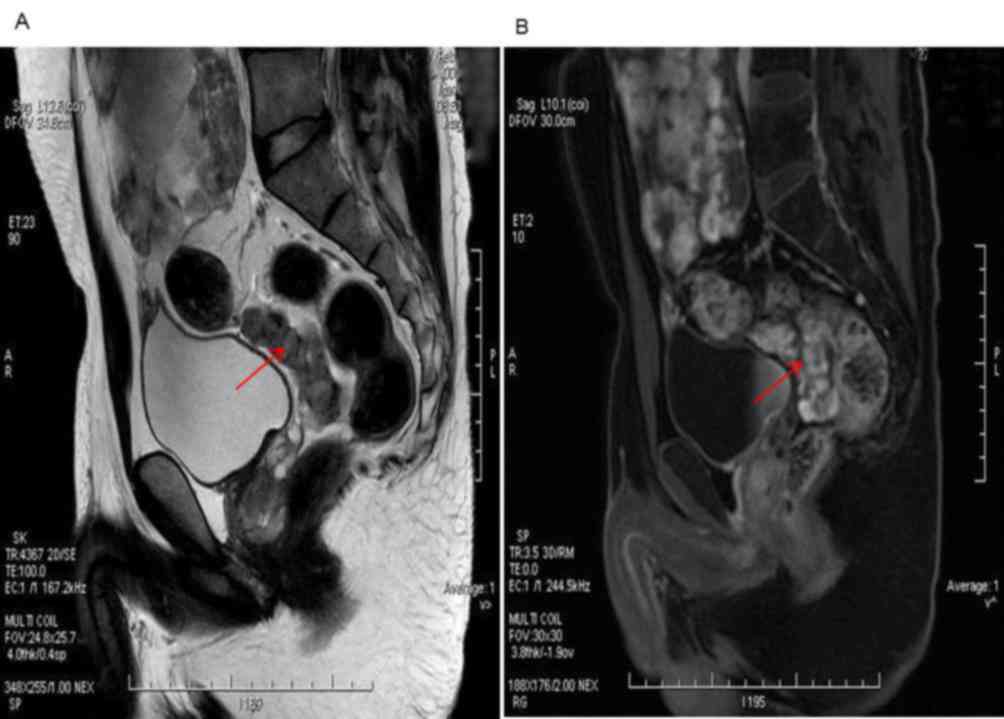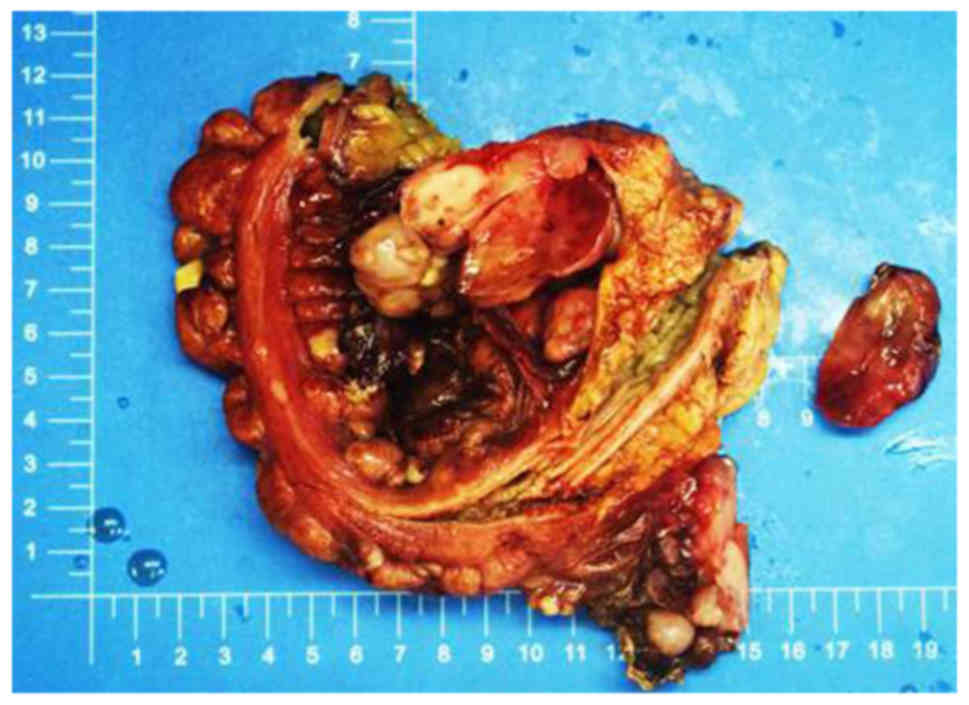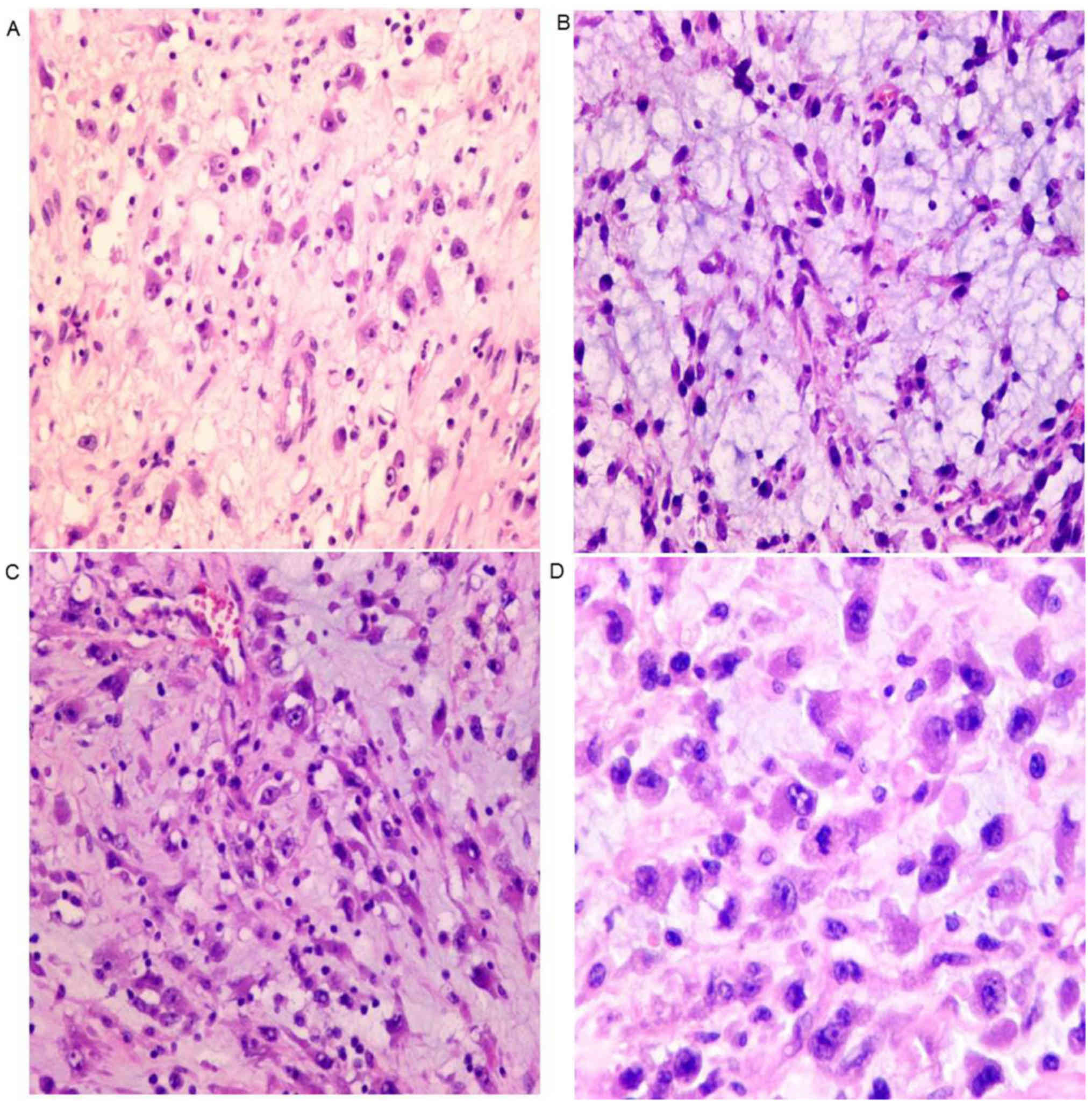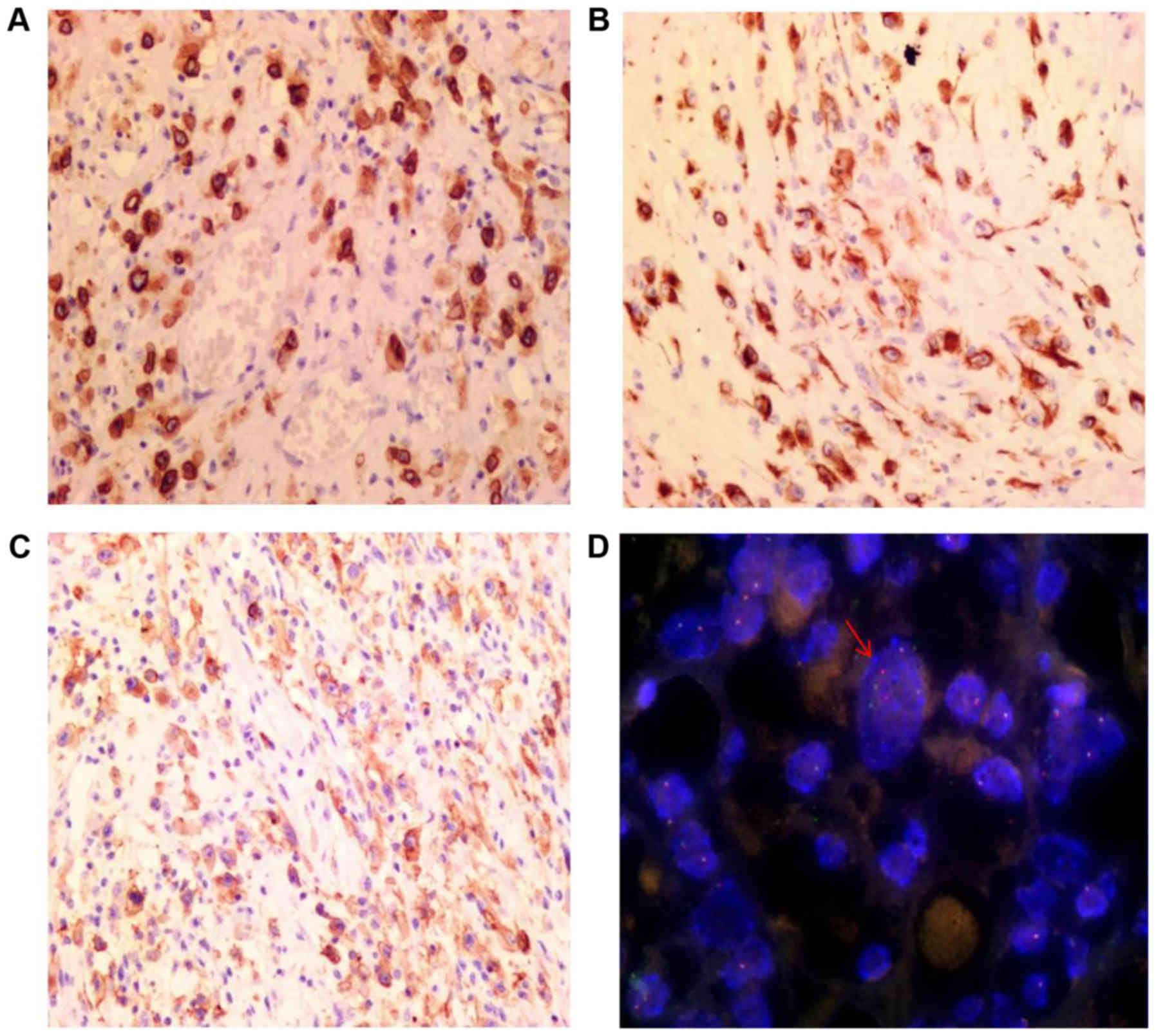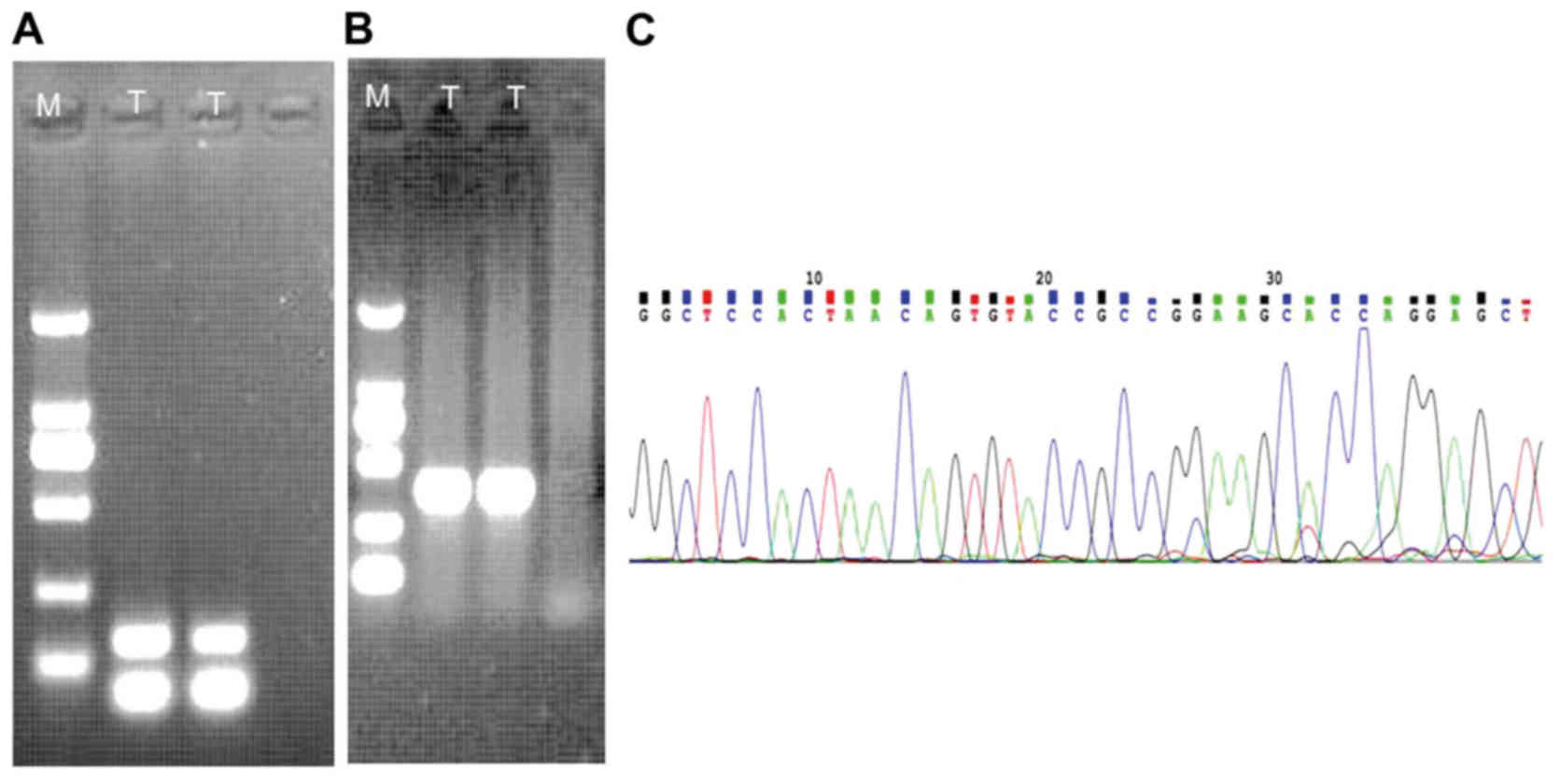|
1
|
Fletcher CDM, Bridge JA, Hogendoorn PCW
and Mertens F: World health organization classification of tumors
of soft tissue and bone. 4th edition. Lyon, France: IARC Press; pp.
83–84. 2013
|
|
2
|
Kirchgesner T, Danse E, Sempoux CH, Annet
L, Dragean ChA, Trefois P, Orabi Abbes N and Kartheuser A:
Mesenteric inflammatory myofibroblastic tumor: MRI and CT imaging
correlated to anatomical pathology. JBR-BTR. 97:301–302.
2014.PubMed/NCBI
|
|
3
|
Gleason BC and Hornick JL: Inflammatory
myofibroblastic tumours: Where are we now? J Clin Pathol.
61:428–437. 2008. View Article : Google Scholar : PubMed/NCBI
|
|
4
|
Mariño-Enríquez A, Wang WL, Roy A,
Lopez-Terrada D, Lazar AJ, Fletcher CD, Coffin CM and Hornick JL:
Epithelioid inflammatory myofibroblastic sarcoma: An aggressive
intra-abdominal variant of inflammatory myofibroblastic tumor with
nuclear membrane or perinuclear ALK. Am J Surg Pathol. 35:135–144.
2011. View Article : Google Scholar : PubMed/NCBI
|
|
5
|
Cook JR, Dehner LP, Collins MH, Ma Z,
Morris SW, Coffin CM and Hill DA: Anaplastic lymphoma kinase (ALK)
expression in the inflammatory myofibroblastic tumor: A comparative
immunohistochemical study. Am J Surg Pathol. 25:1364–1371. 2001.
View Article : Google Scholar : PubMed/NCBI
|
|
6
|
Patel AS, Murphy KM, Hawkins AL, Cohen JS,
Long PP, Perlman EJ and Griffin CA: RANBP2 and CLTC are involved in
ALK rearrangements in inflammatory myofibroblastic tumors. Cancer
Genet Cytogenet. 176:107–114. 2007. View Article : Google Scholar : PubMed/NCBI
|
|
7
|
Ma Z, Hill DA, Collins MH, Morris SW,
Sumegi J, Zhou M, Zuppan C and Bridge JA: Fusion of ALK to the
Ran-binding protein 2 (RANBP2) gene in inflammatory myofibroblastic
tumor. Genes Chromosomes Cancer. 37:98–105. 2003. View Article : Google Scholar : PubMed/NCBI
|
|
8
|
Chen ST and Lee JC: An inflammatory
myofibroblastic tumor in liver with ALK and RANBP2 gene
rearrangement: combination of distinct morphologic,
immunohistochemical, and genetic features. Hum Pathol.
39:1854–1858. 2008. View Article : Google Scholar : PubMed/NCBI
|
|
9
|
Verma S, Turkbey B, Muradyan N, Rajesh A,
Cornud F, Haider MA, Choyke PL and Harisinghani M: Overview of
dynamic contrast-enhanced MRI in prostate cancer diagnosis and
management. AJR Am J Roentgenol. 198:1277–1288. 2012. View Article : Google Scholar : PubMed/NCBI
|
|
10
|
Hashmi AA, Hussain ZF, Faridi N and
Khurshid A: Distribution of Ki67 proliferative indices among WHO
subtypes of non-Hodgkin'slymphoma: Association with other clinical
parameters. Asian Pac J Cancer Prev. 15:8759–8763. 2014. View Article : Google Scholar : PubMed/NCBI
|
|
11
|
Livak KJ and Schmittgen TD: Analysis of
relative gene expression data using real-time quantitative PCR and
the 2(-Delta Delta C(T)) method. Methods. 25:402–408. 2001.
View Article : Google Scholar : PubMed/NCBI
|
|
12
|
Li J, Yin WH, Takeuchi K, Guan H, Huang YH
and Chan JK: Inflammatory myofibroblastic tumor with RANBP2 and ALK
gene rearrangement: A report of two cases and literature review.
Diagn Pathol. 8:1472013. View Article : Google Scholar : PubMed/NCBI
|
|
13
|
Liu Q, Kan Y, Zhao Y, He H and Kong L:
Epithelioid inflammatory myofibroblastic sarcoma treated with ALK
inhibitor: A case report and review of literature. Int J Clin Exp
Pathol. 8:15328–15332. 2015.PubMed/NCBI
|
|
14
|
Kimbara S, Takeda K, Fukushima H, Inoue T,
Okada H, Shibata Y, Katsushima U, Tsuya A, Tokunaga S, Daga H, et
al: A case report of epithelioid inflammatory myofibroblastic
sarcoma with RANBP2-ALK fusion gene treated with the ALK inhibitor,
crizotinib. Jpn J Clin Oncol. 44:868–871. 2014. View Article : Google Scholar : PubMed/NCBI
|
|
15
|
Kurihara-Hosokawa K, Kawasaki I, Tamai A,
Yoshida Y, Yakushiji Y, Ueno H, Fukumoto M, Fukushima H, Inoue T
and Hosoi M: Epithelioid inflammatory myofibroblastic sarcoma
responsive to surgery and an ALK inhibitor in a patient with
panhypopituitarism. Intern Med. 53:2211–2214. 2014. View Article : Google Scholar : PubMed/NCBI
|
|
16
|
Zhou J, Jiang G, Zhang D, Zhang L, Xu J,
Li S, Li W, Ma Y, Zhao A and Zhao Z: Epithelioid inflammatory
myofibroblastic sarcoma with recurrence after extensive resection:
Significant clinicopathologic characteristics of a rare aggressive
soft tissue neoplasm. Int J Clin Exp Pathol. 8:5803–5807.
2015.PubMed/NCBI
|
|
17
|
Wu H, Meng YH, Lu P, Ning HY, Hong L, Kang
XL and Duan MG: Epithelioid inflammatory myofibroblastic sarcoma in
abdominal cavity: A case report and review of literature. Int J
Clin Exp Pathol. 8:4213–4219. 2015.PubMed/NCBI
|
|
18
|
Bai Y, Jiang M, Liang W and Chen F:
Incomplete intestinal obstruction caused by a rare epithelioid
inflammatory myofibroblastic sarcoma of the colon. Medicine
(Baltimore). 94:e23422015. View Article : Google Scholar : PubMed/NCBI
|
|
19
|
Yu L, Liu J, Lao IW, Luo Z and Wang J:
Epithelioid inflammatory myofibroblastic sarcoma: A
clinicopathological, immunohistochemical and molecular cytogenetic
analysis of five additional cases and review of the literature.
Diagn Pathol. 11:672016. View Article : Google Scholar : PubMed/NCBI
|
|
20
|
Jiang Q, Tong HX, Hou YY, Zhang Y, Li JL,
Zhou YH, Xu J, Wang JY and Lu WQ: Identification of EML4-ALK as an
alternative fusion gene in epithelioid inflammatory myofibroblastic
sarcoma. Orphanet J Rare Dis. 12:972017. View Article : Google Scholar : PubMed/NCBI
|
|
21
|
Kozu Y, Isaka M, Ohde Y, Takeuchi K and
Nakajima T: Epithelioid inflammatory myofibroblastic sarcoma
arising in the pleural cavity. Gen Thorac Cardiovasc Surg.
62:191–194. 2014. View Article : Google Scholar : PubMed/NCBI
|
|
22
|
Fu X, Jiang J, Tian XY and Li Z: Pulmonary
epithelioid inflammatory myofibroblastic sarcoma with multiple bone
metastases: Case report and review of literature. Diagn Pathol.
10:1062015. View Article : Google Scholar : PubMed/NCBI
|
|
23
|
Huang W, Beckett BR, Tudorica A, Meyer JM,
Afzal A, Chen Y, Mansoor A, Hayden JB, Doung YC, Hung AY, et al:
Evaluation of soft tissue sarcoma response to preoperative
chemoradiotherapy using dynamic contrast-enhanced magnetic
resonance imaging. Tomography. 2:308–316. 2016. View Article : Google Scholar : PubMed/NCBI
|
|
24
|
Fujiya M and Kohgo Y: ALK inhibition for
the treatment of refractory epithelioid inflammatory
myofibroblastic sarcoma. Intern Med. 53:2177–2178. 2014. View Article : Google Scholar : PubMed/NCBI
|
|
25
|
Faraj SF, Munari E, Guner G, Taube J,
Anders R, Hicks J, Meeker A, Schoenberg M, Bivalacqua T, Drake C
and Netto GJ: Assessment of tumoral PD-L1 expression and
intratumoral CD8+ T cells in urothelial carcinoma. Urology.
85:703.e1–e6. 2015. View Article : Google Scholar
|
|
26
|
Muenst S, Schaerli AR, Gao F, Däster S,
Trella E, Droeser RA, Muraro MG, Zajac P, Zanetti R, Gillanders WE,
et al: Expression of programmed death ligand 1 (PD-L1) is
associated with poor prognosis in human breast cancer. Breast
Cancer Res Treat. 146:15–24. 2014. View Article : Google Scholar : PubMed/NCBI
|
|
27
|
Droeser RA, Hirt C, Viehl CT, Frey DM,
Nebiker C, Huber X, Zlobec I, Eppenberger-Castori S, Tzankov A,
Rosso R, et al: Clinical impact of programmed cell death ligand 1
expression in colorectal cancer. Eur J Cancer. 49:2233–2242. 2013.
View Article : Google Scholar : PubMed/NCBI
|
|
28
|
Fankhauser CD, Curioni-Fontecedro A,
Allmann V, Beyer J, Tischler V, Sulser T, Moch H and Bode PK:
Frequent PD-L1 expression in testicular germ cell tumors. Br J
Cancer. 113:411–413. 2015. View Article : Google Scholar : PubMed/NCBI
|
|
29
|
Straub M, Drecoll E, Pfarr N, Weichert W,
Langer R, Hapfelmeier A, Götz C, Wolff KD, Kolk A and Specht K:
CD274/PD-L1 gene amplification and PD-L1 protein expression are
common events in squamous cell carcinoma of the oral cavity.
Oncotarget. 7:12024–12034. 2016. View Article : Google Scholar : PubMed/NCBI
|
|
30
|
Zandberg DP and Strome SE: The role of the
PD-L1: PD-1 pathway in squamous cell carcinoma of the head and
neck. Oral Oncol. 50:627–632. 2014. View Article : Google Scholar : PubMed/NCBI
|
|
31
|
Patel SP and Kurzrock R: PD-L1 expression
as a predictive biomarker in cancer immunotherapy. Mol Cancer Ther.
14:847–856. 2015. View Article : Google Scholar : PubMed/NCBI
|
|
32
|
Berger R, Rotem-Yehudar R, Slama G, Landes
S, Kneller A, Leiba M, Koren-Michowitz M, Shimoni A and Nagler A:
Phase I safety and pharmacokinetic study of CT-011, a humanized
antibody interacting with PD-1, in patients with advanced
hematologic malignancies. Clin Cancer Res. 14:3044–3051. 2008.
View Article : Google Scholar : PubMed/NCBI
|
|
33
|
Ma W, Gilligan BM, Yuan J and Li T:
Current status and perspectives in translational biomarker research
for PD-1/PD-L1 immunecheckpoint blockade therapy. J Hematol Oncol.
9:472016. View Article : Google Scholar : PubMed/NCBI
|















